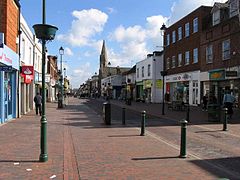Milton-next-Sittingbourne
| Sittingbourne | |
|---|---|
 Sittingbourne High Street |
|
| Sittingbourne shown within Kent | |
| Population | 62,500 |
| OS grid reference | TQ905635 |
| District | |
| Shire county | |
| Region | |
| Country | England |
| Sovereign state | United Kingdom |
| Post town | SITTINGBOURNE |
| Postcode district | ME9, ME10 |
| Dialling code | 01795 |
| Police | Kent |
| Fire | Kent |
| Ambulance | South East Coast |
| EU Parliament | South East England |
| UK Parliament | |
Sittingbourne is an industrial town situated in the Swale district of Kent in south east England, 17 miles (27 km) from Canterbury and 45 miles (72 km) from London. The town sits beside the Roman Watling Street, an ancient British trackway used by the Romans and the Anglo-Saxons and next to the Swale, a strip of sea separating mainland Kent from the Isle of Sheppey. The town became prominent after the death of Thomas Becket in 1170, since it provided a convenient resting point on the road from London to Canterbury and Dover.
Sittingbourne is growing rapidly due to a number of large residential developments, and its railway line links to London Victoria and HS1 to St Pancras International, the journey taking about an hour from Sittingbourne railway station.
Sittingbourne owes its name to a modernised version of an observation on its location. The town's name came from the fact that there is a small stream or "bourne" running underground in part of the town. Hasted writing in the 1790s in his History of Kent states that:
The Kent Hundred Rolls of 1274-5, preserved in the National Archives, record Sittingbourne as Sydingeburn in the following entries " Item dicunt quod Johannes Maresescall de Synele tenet unam parvam purpresturam in villa de Sydingeburn et solvit domino regi per annum 1d et dominus rex nichil perdit et quod Petrus de London tenet unam parvam purpresturam in villa de Sydingeburn et solvit inde per annum domino regi 1d et rex nichil perdit." Translated as, "Then they say John Marshall de Synele holds one small encroachment in the vill of Sittingbourne and he pays the lord king 1d. each year and the lord king loses nothing and that Peter of London holds one small encroachment in the vill of Sittingbourne and he pays 1d. each year to the lord king and the king loses nothing."
There is evidence of settlement in the area before 2000 BC, with farming and trading tribes living inland to avoid attack, yet close enough to access the sea at Milton Creek. In AD 43 the Romans invaded Kent, and to make access quicker between London and Dover, built Watling Street, which passed straight through Sittingbourne. As a point where sea access met road access, the port of Milton Regis became the Roman administrative centre for the area, with some 20 villas so far discovered, but Sittingbourne remained a minor hamlet throughout Roman times. Most Roman finds in this area were due to the efforts of 19th century brick makers who used topsoil to make bricks, and uncovered the finds; and preserved thanks to banker George Payne, who preserved or bought materials and published his works in 1893 in Collectanea Cantiana.
...
Wikipedia

